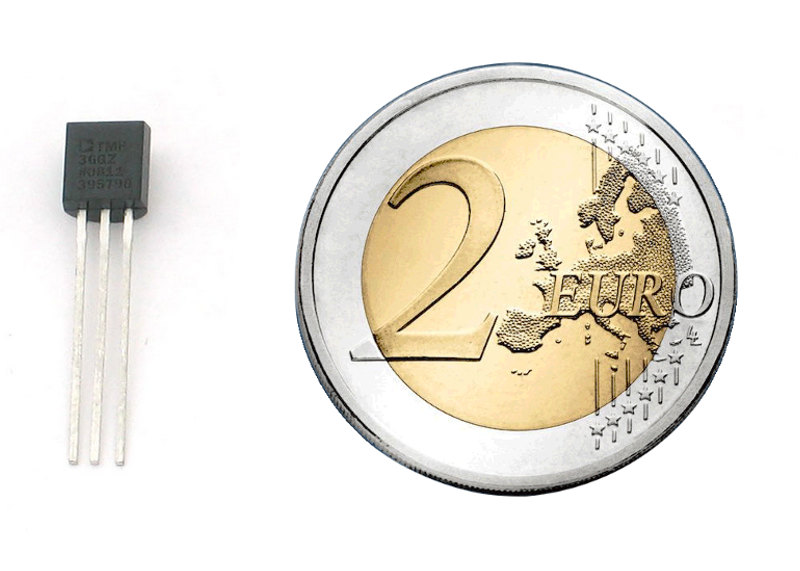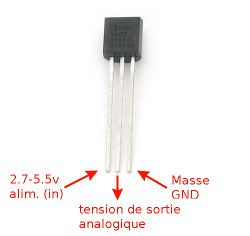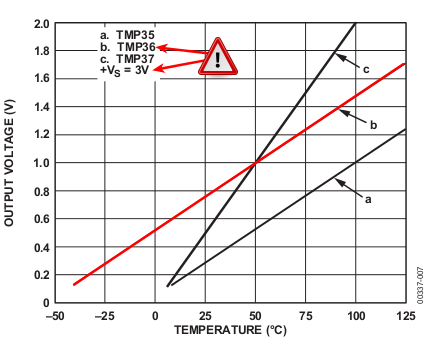Différences entre versions de « Senseur Température »
(Page créée avec « == Introduction == An analog temperature sensor is pretty easy to explain, its a chip that tells you what the ambient temperature is! Fichier:TMP36-intro.jpg These sens... ») |
|||
| Ligne 6 : | Ligne 6 : | ||
These sensors use a solid-state technique to determine the temperature. That is to say, they don't use mercury (like old thermometers), [http://en.wikipedia.org/wiki/Bimetallic_strip bimetalic strips] (like in some home thermometers or stoves), nor do they use [http://en.wikipedia.org/wiki/Thermistor thermistors] (temperature sensitive resistors). Instead, they use the fact as temperature increases, the voltage across a diode increases at a known rate. (Technically, this is actually the voltage drop between the base and emitter - the Vbe - of a transistor.) By precisely amplifying the voltage change, it is easy to generate an analog signal that is directly proportional to temperature. There have been some improvements on the technique but, essentially that is how temperature is measured. | These sensors use a solid-state technique to determine the temperature. That is to say, they don't use mercury (like old thermometers), [http://en.wikipedia.org/wiki/Bimetallic_strip bimetalic strips] (like in some home thermometers or stoves), nor do they use [http://en.wikipedia.org/wiki/Thermistor thermistors] (temperature sensitive resistors). Instead, they use the fact as temperature increases, the voltage across a diode increases at a known rate. (Technically, this is actually the voltage drop between the base and emitter - the Vbe - of a transistor.) By precisely amplifying the voltage change, it is easy to generate an analog signal that is directly proportional to temperature. There have been some improvements on the technique but, essentially that is how temperature is measured. | ||
| − | [[Fichier:TMP36-pinout.jpg]] | + | [[Fichier:TMP36-pinout.jpg|250px]] |
Because these sensors have no moving parts, they are precise, never wear out, don't need calibration, work under many environmental conditions, and are consistant between sensors and readings. Moreover they are very inexpensive and quite easy to use. | Because these sensors have no moving parts, they are precise, never wear out, don't need calibration, work under many environmental conditions, and are consistant between sensors and readings. Moreover they are very inexpensive and quite easy to use. | ||
Version du 5 janvier 2013 à 23:16
Introduction
An analog temperature sensor is pretty easy to explain, its a chip that tells you what the ambient temperature is!
These sensors use a solid-state technique to determine the temperature. That is to say, they don't use mercury (like old thermometers), bimetalic strips (like in some home thermometers or stoves), nor do they use thermistors (temperature sensitive resistors). Instead, they use the fact as temperature increases, the voltage across a diode increases at a known rate. (Technically, this is actually the voltage drop between the base and emitter - the Vbe - of a transistor.) By precisely amplifying the voltage change, it is easy to generate an analog signal that is directly proportional to temperature. There have been some improvements on the technique but, essentially that is how temperature is measured.
Because these sensors have no moving parts, they are precise, never wear out, don't need calibration, work under many environmental conditions, and are consistant between sensors and readings. Moreover they are very inexpensive and quite easy to use.
Quelques informations
These stats are for the temperature sensor in the Adafruit shop, the Analog Devices TMP36 (-40 to 150C). Its very similar to the LM35/TMP35 (celsius output) and LM34/TMP34 (farenheit output). The reason we went with the '36 instead of the '35 or '34 is that this sensor has a very wide range and doensn't require a negative voltage to read sub-zero temperatures. Otherwise, the functionality is basically the same.
- Taille: boitier TO-92 à 3 broches (similaire à un transistor)
- Prix: ~2.50 eur disponible chez MCHobby
- Gamme de température: -40°C a 150°C / -40°F a 302°F
- Tension de sortie: 0.1V (-40°C) to 2.0V (150°C) mais la précision diminue après 125°C
- Tension d'alimentation: 2.7V a 5.5V
- Courant de charge: 0.05 mA
- Fiche technique
Comment mesurer la température
Comment calculer la température Il faut donc convertir la tension analogique en degré. Comme le TMP36 permet de mesurer des température négatives, le 0 degré Celsius est placé à une offset de 500 milliVolts. Ainsi, toute mesure inférieur à 500 mv correspondra à une température négative.
La formule est la suivante pour le TMP36:
Temp en °C = ( Tension_de_sortie_en_milliVolts - 500) / 10
Donc, si la tension de sortie est de 1 Volts, la température correspondante est de
(1000 - 500)/10
Soit 50 degrés Celcius.
Source: AdaFruit
Traduit avec l'autorisation d'AdaFruit Industries - Translated with the permission from Adafruit Industries - www.adafruit.com
Toute référence, mention ou extrait de cette traduction doit être explicitement accompagné du texte suivant : « Traduction par MCHobby (www.MCHobby.be) - Vente de kit et composants » avec un lien vers la source (donc cette page) et ce quelque soit le média utilisé.
L'utilisation commercial de la traduction (texte) et/ou réalisation, même partielle, pourrait être soumis à redevance. Dans tous les cas de figures, vous devez également obtenir l'accord du(des) détenteur initial des droits. Celui de MC Hobby s'arrêtant au travail de traduction proprement dit.


